Bitget: топ-4 за щоденним обсягом торгівлі!
Частка ринку BTC62.21%
Нові лістинги на Bitget : Pi
BTC/USDT$104366.94 (+0.52%)Індекс страху та жадібності70(Жадібність)
Індекс сезону альткоїнів:0(Сезон Bitcoin)
Загальний чистий приплив коштів у спотові ETF на Bitcoin +$321.4M (1 д.); +$2.02B (7 дн.).Вітальний подарунковий пакет для нових користувачів вартістю 6200 USDT.Отримати
Торгуйте в будь-який час у будь-якому місці через застосунок Bitget. Завантажити
Bitget: топ-4 за щоденним обсягом торгівлі!
Частка ринку BTC62.21%
Нові лістинги на Bitget : Pi
BTC/USDT$104366.94 (+0.52%)Індекс страху та жадібності70(Жадібність)
Індекс сезону альткоїнів:0(Сезон Bitcoin)
Загальний чистий приплив коштів у спотові ETF на Bitcoin +$321.4M (1 д.); +$2.02B (7 дн.).Вітальний подарунковий пакет для нових користувачів вартістю 6200 USDT.Отримати
Торгуйте в будь-який час у будь-якому місці через застосунок Bitget. Завантажити
Bitget: топ-4 за щоденним обсягом торгівлі!
Частка ринку BTC62.21%
Нові лістинги на Bitget : Pi
BTC/USDT$104366.94 (+0.52%)Індекс страху та жадібності70(Жадібність)
Індекс сезону альткоїнів:0(Сезон Bitcoin)
Загальний чистий приплив коштів у спотові ETF на Bitcoin +$321.4M (1 д.); +$2.02B (7 дн.).Вітальний подарунковий пакет для нових користувачів вартістю 6200 USDT.Отримати
Торгуйте в будь-який час у будь-якому місці через застосунок Bitget. Завантажити



Ціна BigONE TokenONE
Не представлено на платформі
Валюта котирування:
UAH
Дані отримані від сторонніх постачальників. Ця сторінка та надана на ній інформація не є висловленням підтримки жодної конкретної криптовалюти. Хочете торгувати монетами, представленими на біржі? Клацніть тут
₴0.02293+1.42%1D
Графік ціни
Графік цін BigONE Token (ONE/UAH)
Останнє оновлення 2025-05-11 10:21:48(UTC+0)
Ринкова капіталізація:₴196,851,319.94
Повністю розбавлена ринкова капіталізація:₴196,851,319.94
Обсяг (24 г):--
Обсяг за 24 г / Ринкова капіталізація:0.00%
Макс. за 24 г:₴0.02327
Мін. за 24 год:₴0.02273
Історичний максимум:₴496.27
Історичний мінімум:₴0.01669
Циркулююча пропозиція:8,584,171,500 ONE
Загальна пропозиція:
8,584,171,727.15ONE
Показник обігу:99.00%
Максимальна пропозиція:
13,508,522,147.21ONE
Ціна в BTC:0.{8}5286 BTC
Ціна в ETH:0.{6}2202 ETH
Ціна за ринковою капіталізацією BTC:
₴10,038.81
Ціна за ринковою капіталізацією ETH:
₴1,464.39
Контракти:
0x04ba...7357bf0(BNB Smart Chain (BEP20))
Більше
Як ви ставитеся до BigONE Token сьогодні?
Примітка. Ця інформація надається лише для ознайомлення.
Аналітичний ШІ-звіт про BigONE Token
Основні події ринку криптовалют за сьогодніПереглянути звіт
Ціна BigONE Token у UAH сьогодні
Сьогодні актуальна ціна BigONE Token становить ₴0.02293 UAH, з поточною ринковою капіталізацією ₴196.85M. Ціна BigONE Token зросла на 1.42% за останні 24 години, а обсяг торгівлі за 24 години склав ₴0.00. Коефіцієнт конвертації ONE/UAH (BigONE Token – UAHоновлюється в реальному часі.
Історія ціни BigONE Token (UAH)
За останній рік ціна BigONE Token зросла на -45.86%. Найвища ціна в UAH минулого року була ₴0.04631, а найнижча ціна в UAH — ₴0.01669.
ЧасЗміна ціни (%) Найнижча ціна
Найнижча ціна Найвища ціна
Найвища ціна 
 Найнижча ціна
Найнижча ціна Найвища ціна
Найвища ціна 
24h+1.42%₴0.02273₴0.02327
7d+11.57%₴0.02029₴0.02327
30d+12.15%₴0.01827₴0.02329
90d-17.21%₴0.01827₴0.02854
1y-45.86%₴0.01669₴0.04631
За весь час-99.99%₴0.01669(2024-09-06, 247 дні(в) тому )₴496.27(2018-01-08, 7 р. тому )
Яка найвища ціна BigONE Token?
Максимальна ціна (ATH) BigONE Token у UAH становила ₴496.27 і була зафіксована 2018-01-08. Порівняно з ATH BigONE Token, поточна ціна BigONE Token знизилася на 100.00%.
Яка найнижча ціна BigONE Token?
Мінімальна ціна (ATL) BigONE Token у UAH становила ₴0.01669 і була зафіксована 2024-09-06. Порівняно з ATL BigONE Token, поточна ціна BigONE Token збільшилася на 37.40%.
Прогноз ціни BigONE Token
Якою буде ціна ONE у 2026?
Ґрунтуючись на моделі прогнозування історичних показників ONE, ціна ONE може досягти ₴0.02486 у ₴0.02486 році.
Якою буде ціна ONE у 2031?
У 2031 ціна ONE може зрости на +36.00%. Прогнозується, що до кінця 2031 ціна ONE досягне ₴0.06105, а сукупна ROI становитиме +165.35%.
Відповіді на поширені запитання
Яка поточна ціна BigONE Token?
Актуальна ціна BigONE Token становить ₴0.02 за (ONE/UAH), актуальна ринкова капіталізація становить ₴196,851,319.94 UAH. Вартість BigONE Token часто коливається через безперервну активність на криптовалютному ринку. Актуальну ціну BigONE Token в режимі реального часу та дані на історії ви завжди можете переглянути на Bitget.
Який обсяг торгівлі BigONE Token за 24 години?
За останні 24 години обсяг торгівлі BigONE Token становить ₴0.00.
Який історичний максимум BigONE Token?
Історичний максимум BigONE Token становить ₴496.27. Цей історичний максимум є найвищою ціною для BigONE Token з моменту його запуску.
Чи можу я купити BigONE Token на Bitget?
Так, BigONE Token зараз можна придбати на централізованій біржі Bitget. Щоб отримати докладніші інструкції, перегляньте наш корисний посібник Як купити .
Чи можу я отримувати постійний дохід від інвестування в BigONE Token?
Звичайно, Bitget забезпечує платформа для стратегічної торгівлі з розумними торговими ботами для автоматизації ваших угод і отримання прибутку.
Де можна купити BigONE Token за найнижчою комісією?
Ми раді повідомити, що платформа для стратегічної торгівлі тепер доступний на Bitget. Bitget пропонує найкращі комісії за торгівлю та глибину ринку, щоб забезпечити прибутковість інвестицій для трейдерів.
Утримання BigONE Token за концентрацією
Кити
Інвестори
Рітейл
Адреси BigONE Token за часом утримання
Холдери
Cruisers
Трейдери
Графік ціни coinInfo.name (12) у режимі реального часу

Міжнародні ціни BigONE Token
Скільки зараз коштує BigONE Token в інших валютах? Останнє оновлення: 2025-05-11 10:21:48(UTC+0)
ONE до MXN
Mexican Peso
Mex$0.01ONE до GTQGuatemalan Quetzal
Q0ONE до CLPChilean Peso
CLP$0.52ONE до HNLHonduran Lempira
L0.01ONE до UGXUgandan Shilling
Sh2.02ONE до ZARSouth African Rand
R0.01ONE до TNDTunisian Dinar
د.ت0ONE до IQDIraqi Dinar
ع.د0.72ONE до TWDNew Taiwan Dollar
NT$0.02ONE до RSDSerbian Dinar
дин.0.06ONE до DOPDominican Peso
RD$0.03ONE до MYRMalaysian Ringgit
RM0ONE до GELGeorgian Lari
₾0ONE до UYUUruguayan Peso
$0.02ONE до MADMoroccan Dirham
د.م.0.01ONE до AZNAzerbaijani Manat
₼0ONE до OMROmani Rial
ر.ع.0ONE до SEKSwedish Krona
kr0.01ONE до KESKenyan Shilling
Sh0.07ONE до UAHUkrainian Hryvnia
₴0.02- 1
- 2
- 3
- 4
- 5
Нові лістинги на Bitget
Нові лістинги
Купити більше
Де можна купити криптовалюту?
Купуйте криптовалюту в застосунку Bitget
Щоб купити криптовалюту за допомогою кредитної картки або банківського переказу, вам потрібно зареєструватися. Це займе всього кілька хвилин.
Video section — Швидка верифікація, швидке здійснення угод

Як пройти верифікацію особи на Bitget та захистити себе від шахрайства
1. Увійдіть у свій акаунт Bitget.
2. Якщо ви ще не маєте акаунта на Bitget, перегляньте нашу інструкцію.
3. Наведіть курсор на значок вашого профілю, клацніть «Не верифікований», а потім «Верифікувати».
4. Оберіть країну або регіон, де ви отримали посвідчення особи, та тип посвідчення. Далі дотримуйтесь підказок на екрані.
5. Виберіть «Верифікація з мобільного» або «ПК».
6. Введіть свої дані, надішліть копію посвідчення особи та зробіть селфі.
7. Після цього подайте заявку, та все готово.
Інвестиції в криптовалюту, включаючи купівлю BigONE Token онлайн через Bitget, підлягають ринковому ризику. Bitget надає вам прості та зручні способи купівлі BigONE Token, і ми намагаємося максимально повно інформувати наших користувачів про кожну криптовалюту, яку ми пропонуємо на біржі. Однак ми не несемо відповідальності за результати, які можуть виникнути в результаті купівлі BigONE Token. Ця сторінка та будь-яка інформація, що тут міститься, не є схваленням будь-якої конкретної криптовалюти.
Ресурси ONE
Теги:
Оцінки BigONE Token
Середні оцінки від спільноти
4.6
Цей контент призначено лише для інформаційних цілей.
Bitget Insights

mox
1год
The 60th birthday is now the most common in Germany.
This single fact says everything about where our society is heading: an aging population, a shrinking workforce, and a pension system under enormous strain. In 1950, six workers funded the pension of one retiree. Today? Just
SIX-1.60%
ONE-2.73%

WEB3-TREASURE-ZON
1год
IS PI NETWORK ABOUT TO PUMP? GET READY FOR THE RISE!
The long wait might finally be over — PI NETWORK is showing serious signs of life, and believers all over the world are buzzing with excitement!
Pi, once called “just a phone app,” is now getting ready to shock the crypto world!
WHY PI MIGHT BE THE NEXT BIG THING:
✅ Massive Global Community — Over 47 million pioneers worldwide! 🌍
✅ Utility-Based Ecosystem — Real apps, services & businesses built on Pi! 🛒🧾
✅ Decentralization at Heart — Fair mining for everyone via mobile phone! 📱🔒
✅ Mainnet Launch Incoming — Strong signals that open mainnet is near! 🧑💻🚀
As exchanges quietly start listing test prices and the team hints at upcoming mainnet features, whispers of a potential price recovery are growing louder. Some Pi believers are even predicting a future price above $10, $50, or more once full utility and listings roll in! 📈👀
Remember this:
> "If you missed Bitcoin early, don’t sleep on Pi."
"The Pi you mined for free could change your life one day!"
ARE YOU STILL HOLDING YOUR PI?
It’s not just an app — it’s a movement powered by belief, patience, and a powerful community.
Hold tight. Stay strong. The Pi pump might just be around the corner.
✨🔐📲💎🚀
#PiNetwork #PiIsComing #CryptoFuture #NextBigThing #HoldPiStrong
BITCOIN-7.13%
MOBILE-4.86%
BGUSER-8SLTXCVR
2год
#SHM
SHM is the native cryptocurrency token of the Shardeum network, a blockchain platform designed to address scalability and decentralization challenges in the blockchain space. Shardeum employs a unique approach called dynamic state sharding, which allows the network to scale dynamically based on demand, ensuring low gas fees and high transaction throughput.
### Key Features and Use Cases of SHM Token:
1. **Dynamic State Sharding**: Shardeum's dynamic state sharding technology enables the network to adjust the number of shards based on network load, ensuring efficient transaction processing and scalability.
2. **Low Gas Fees**: By leveraging dynamic state sharding, Shardeum aims to provide low gas fees, making it an attractive option for decentralized applications (DApps) and users.
3. **Decentralization**: Shardeum focuses on achieving true decentralization, allowing anyone with minimal hardware to become a validator and participate in network security and transaction validation.
4. **Tokenomics**: SHM follows a dynamic supply model, similar to leading Layer 1 blockchains like Ethereum. The initial supply of SHM was set at 249 million tokens, with allocations for the foundation, team, sales, and ecosystem development.
5. **Token Sale and Mainnet Launch**: Shardeum conducted a token sale for SHM, which ran from March 19, 2025, to May 4, 2025, just before the mainnet launch on May 5, 2025. The token sale offered early access to SHM at favorable pricing.
6. **Trading and Exchanges**: SHM tokens are traded on various centralized cryptocurrency exchanges, with Bitget being one of the most popular platforms for trading SHM/USDT pairs.
7. **Investment Potential**: SHM tokens have gained attention in the cryptocurrency market for their investment potential, particularly due to Shardeum's innovative technology and focus on scalability and decentralization.
### Conclusion:
SHM token represents a significant development in the blockchain space, offering a scalable, decentralized, and low-cost solution for DApps and users. With its dynamic state sharding technology and focus on decentralization, Shardeum aims to address key challenges in the blockchain industry and provide a robust platform for the future of decentralized applications.$SHM
GAS-2.94%
ANYONE-9.42%
BGUSER-8SLTXCVR
2год
# OBOL: Redefining Staking Security Through Distributed Validator Technology
## Introduction
OBOL represents a paradigm shift in blockchain staking infrastructure, pioneering a technology known as Distributed Validator Technology (DVT) that fundamentally transforms how validators secure proof-of-stake networks. As Ethereum and other major blockchains have transitioned to proof-of-stake consensus mechanisms, the need for resilient, secure, and decentralized validation infrastructure has become increasingly critical. OBOL addresses these challenges through an innovative approach that distributes validator responsibilities across multiple independent operators, enhancing security, reliability, and decentralization in the staking ecosystem. This comprehensive analysis explores OBOL's technological architecture, ecosystem components, and potential impact on the future of blockchain infrastructure.
## The Validator Security Challenge
To appreciate OBOL's significance, one must first understand the fundamental challenges in traditional validator setups:
### Single Points of Failure
Conventional validators operate on single machines with single private keys, creating vulnerability to:
- Hardware failures causing downtime and slashing penalties
- Network outages leading to missed attestations
- Security breaches that could compromise validator keys
- Geographic and infrastructure risks
### Centralization Pressures
Economic and technical factors push staking toward centralization:
- Economies of scale favoring large institutional operators
- Technical complexity creating barriers for individual participation
- Risk management challenges for smaller operators
- Limited geographic diversity in node operation
### Key Management Risks
Validator key security presents significant challenges:
- Compromised keys can lead to catastrophic slashing events
- Backup strategies create additional security vulnerabilities
- Key rotation complexity limits operational flexibility
- Limited options for secure multi-party key management
## OBOL's Technical Architecture
OBOL has developed a comprehensive technical stack to address these challenges:
### Distributed Key Generation (DKG)
At the core of OBOL's innovation is a secure method for creating distributed validator keys:
- Validators are created through a multi-party computation ceremony
- No single party ever possesses the complete validator key
- Key shares are distributed among multiple independent operators
- Threshold signature schemes enable collaborative signing
### Charon Client
The primary software implementation enabling distributed validation:
- Acts as middleware between consensus and execution clients
- Coordinates message passing between distributed validator nodes
- Ensures synchronized consensus participation across the cluster
- Implements BFT-style consensus among validator nodes
### Middleware Network
A specialized communication infrastructure that enables:
- Secure and timely communication between distributed validator components
- Monitoring and performance analytics across validator clusters
- Network-wide coordination for optimal performance
- Cross-operator synchronization and timing guarantees
### Security Enhancements
OBOL implements several innovations to enhance validator security:
- Multi-factor authentication for validator operations
- Geographic distribution requirements for enhanced resilience
- Automated monitoring and alert systems
- Slashing protection mechanisms
## The OBOL Protocol
The OBOL ecosystem operates through a comprehensive protocol that governs distributed validator operation:
### Validator Clusters
The fundamental operational units within the OBOL ecosystem:
- Groups of 4-16 independent nodes operating as a single validator
- Configured with custom threshold requirements for signing operations
- Can span multiple operators, jurisdictions, and infrastructure providers
- Maintain synchronized state through the Charon middleware
### Cluster Configuration Options
OBOL enables flexible validation setups:
- **Solo Clusters**: Individual operators running multiple nodes for self-redundancy
- **Trusted Clusters**: Known participants collaborating on validation
- **Permissionless Clusters**: Open participation through economic staking requirements
- **Institutional Clusters**: Enterprise-grade setups with enhanced security requirements
### Performance Optimization
The protocol implements several mechanisms to ensure optimal validator performance:
- Latency-aware communication protocols
- Leader selection algorithms to minimize communication overhead
- Fallback mechanisms for node failures
- Graduated consensus thresholds based on network conditions
### Economic Security
OBOL aligns economic incentives for distributed validation:
- Staking requirements for middleware operators
- Performance-based reward distribution
- Slashing conditions for protocol violations
- Reputation systems for operator selection
## The OBOL Ecosystem
The OBOL protocol supports a comprehensive ecosystem of participants and services:
### Validator Operators
Individual and institutional stakers who leverage DVT to enhance the security and reliability of their validation operations, including:
- Individual ETH stakers seeking enhanced security
- Institutional staking providers managing customer assets
- DAOs distributing validator control across their membership
- Protocol treasuries securing their staked assets
### Middleware Operators
Specialized service providers maintaining the infrastructure required for seamless communication between distributed validator components:
- Running communication relays for distributed validator clusters
- Providing performance monitoring and alerting services
- Supporting discovery mechanisms for cluster formation
- Operating specialized hardware for optimized signature aggregation
### Technology Integrators
Service providers incorporating OBOL's DVT protocol into their offerings:
- Staking-as-a-service platforms
- Hardware security module manufacturers
- Wallet providers offering staking services
- Node operation platforms and infrastructure providers
### Developer Community
Technical contributors building tools, interfaces, and integrations that extend the capabilities of the OBOL network:
- Creating user interfaces for distributed validator management
- Developing monitoring and analytics tools
- Building middleware extensions for specialized use cases
- Creating educational resources and implementation guides
## Implementation and Deployment
OBOL's technology has been deployed across several phases:
### Testnet Implementations
The protocol has undergone extensive testing through:
- Multiple testnet iterations with increasing complexity
- Simulated fault scenarios to test resilience
- Performance benchmarking under various network conditions
- Security audits from multiple independent firms
### Mainnet Deployment
OBOL's production implementation follows a staged approach:
- Initial deployment with limited validator clusters
- Gradual expansion to more operators and validator types
- Integration with major staking services
- Support for additional proof-of-stake networks beyond Ethereum
### Integration Partners
OBOL has established partnerships with key ecosystem participants:
- Major staking providers implementing DVT for customer assets
- Hardware security module manufacturers supporting distributed key shares
- Infrastructure providers offering OBOL-compatible node setups
- Development teams building complementary staking infrastructure
## Impact on the Staking Ecosystem
OBOL's distributed validator technology has far-reaching implications:
### Enhanced Security
DVT fundamentally improves staking security through:
- Elimination of single points of failure in validator operation
- Distribution of risk across multiple independent operators
- Improved resilience against hardware and network failures
- Enhanced protection against sophisticated attacks
### Increased Decentralization
The technology enables greater decentralization by:
- Lowering the risk threshold for individual participants
- Enabling collaborative validation across jurisdictions
- Creating new models for community-based validation
- Reducing the advantage of large-scale centralized operations
### Institutional Adoption
DVT addresses key concerns for institutional participation:
- Meets enterprise-grade security requirements
- Enables separation of duties for regulatory compliance
- Provides redundancy guarantees required by financial institutions
- Supports sophisticated key management policies
### Network Health Improvements
The broader network benefits from:
- More geographically distributed validation
- Higher aggregate uptime across validators
- Reduced correlation of failures during network stress
- More participants in the validation ecosystem
## Future Development Roadmap
OBOL's future development focuses on several key areas:
### Cross-Chain Expansion
Extending DVT beyond Ethereum to other proof-of-stake networks:
- Adapting the protocol for different consensus mechanisms
- Creating a universal standard for distributed validation
- Building cross-chain validator management tools
- Enabling validators to secure multiple networks simultaneously
### Enhanced Security Features
Continuing innovations in validation security:
- Implementation of post-quantum cryptographic techniques
- Advanced threat detection and prevention mechanisms
- Automated security response systems
- Enhanced privacy for validator operations
### Governance and Decentralization
Evolving the protocol's governance model:
- Transitioning to community-driven development
- Implementing on-chain governance mechanisms
- Creating incentive structures for ecosystem contributors
- Developing standards for distributed validator operation
### Advanced Operational Tools
Building sophisticated tooling for validator operators:
- Comprehensive analytics dashboards
- Performance optimization suggestions
- Automated cluster management
- Advanced monitoring and alerting systems
## Challenges and Considerations
Despite its promising approach, OBOL faces several challenges:
### Technical Complexity
The distributed nature of DVT introduces additional complexity:
- Coordination requirements increase operational overhead
- Latency considerations impact validator performance
- Implementation errors could affect multiple validators
- Testing and auditing distributed systems presents challenges
### Adoption Hurdles
The transition to distributed validation faces practical barriers:
- Existing validators may resist changing established setups
- Integration with current staking infrastructure requires effort
- Educational gaps limit understanding of DVT benefits
- Short-term operational changes may discourage migration
### Performance Optimizations
Maintaining competitive performance requires ongoing development:
- Minimizing additional latency from distribution
- Optimizing communication protocols for efficiency
- Balancing security with operational speed
- Adapting to evolving network requirements
### Regulatory Considerations
The evolving regulatory landscape presents challenges:
- Varying jurisdictional requirements for validator operation
- Questions around regulatory responsibility in distributed setups
- Compliance considerations for institutional operators
- Data privacy concerns across international boundaries
## Conclusion
OBOL represents a transformative approach to blockchain validation through its distributed validator technology. By addressing fundamental security and reliability challenges in staking infrastructure, OBOL has positioned itself as an essential component of the maturing proof-of-stake ecosystem. As blockchain networks increasingly form the foundation for critical financial infrastructure, solutions that enhance security and resilience while maintaining decentralization will prove invaluable.
For individual stakers, institutions, and the broader blockchain community, OBOL offers a path toward more secure, reliable, and truly decentralized validation—fulfilling the original promise of proof-of-stake consensus while addressing practical operational challenges. While the implementation of distributed validation represents a significant shift in operational practices, the enhanced security and reliability benefits make a compelling case for widespread adoption across the staking ecosystem.
As proof-of-stake networks continue to secure trillions in value and form the foundation of the decentralized economy, technologies like OBOL's DVT will likely transition from innovative options to industry standards—representing an important evolution in how we collectively secure and maintain blockchain networks.$OBOL
CORE-2.71%
OBOL+1.25%
Habibushoot
2год
Altcoins 🔥
As long as #ETH is moving within the Triangle, this is the time to Accumulate as much as you can..
Remember one thing, Once the train slips out of your hand, it won't come back..
One more thing, ETH leads the Altcoin Rally. (KING for a Reason)
ETH-3.07%
ONE-2.73%
Пов'язані активи
Популярні криптовалюти
Підбірка з 8 найкращих криптовалют за ринковою капіталізацією.
Нещодавно додано
Останні додані криптовалюти.
Порівнювана ринкова капіталізація
Серед усіх активів на Bitget ці 8 найближчі до BigONE Token за ринковою капіталізацією.
Додаткова інформація про BigONE Token
Пов'язано з монетами
Пов'язано з торгівлею

































